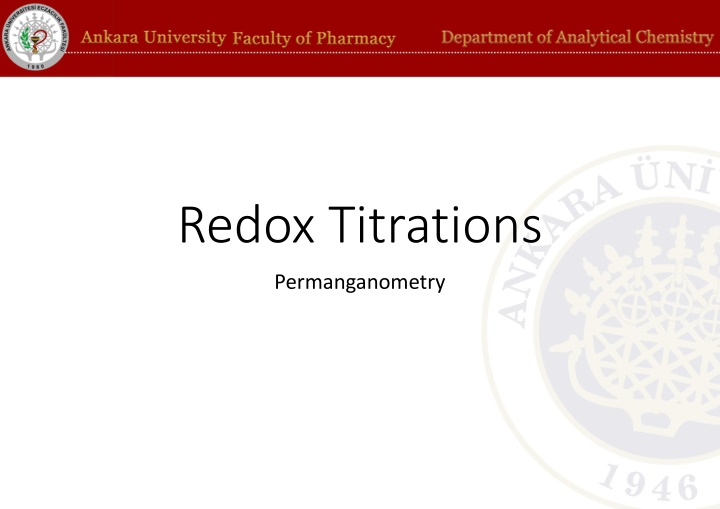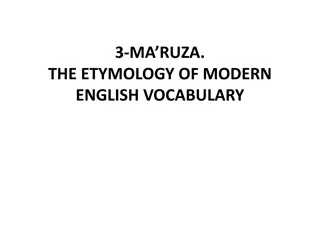
Permanganometry in Redox Titrations
Explore how redox titrations, specifically permanganometry, utilize KMnO4 as a standard solution to determine the endpoint based on color changes. Learn about the preparation of the 0.02 M KMnO4 solution and the standardization process for accurate results. Discover the significance of autoindicators in permanganometry and the importance of maintaining dark conditions during the titration process.
Download Presentation

Please find below an Image/Link to download the presentation.
The content on the website is provided AS IS for your information and personal use only. It may not be sold, licensed, or shared on other websites without obtaining consent from the author. If you encounter any issues during the download, it is possible that the publisher has removed the file from their server.
You are allowed to download the files provided on this website for personal or commercial use, subject to the condition that they are used lawfully. All files are the property of their respective owners.
The content on the website is provided AS IS for your information and personal use only. It may not be sold, licensed, or shared on other websites without obtaining consent from the author.
E N D
Presentation Transcript
Redox Titrations Permanganometry
Redox Titrations and Redox Titrations and Permanganometry Permanganometry Redox titration is a titration based on the oxidation-reduction reaction between analyte and titrant. The titration in which KMnO4is used as a standard solution is called permanganometry. The reduction of KMnO4 varies depending on the pH of the medium. + 8H++ 5e Mn+2+ 4H2O MnO2+ 4OH MnO4 MnO4 Acidic medium: + 2H2O + 3e Alkali medium : In this laboratory the permanganometric titrations will be performed in acidic medium.
KMnO KMnO4 4is an autoindicator. is an autoindicator. solution has a purple color whereas its reduction product Mn+2is colorless. MnO4 The end point of a reaction can be indicated by the occurence or disappearance of pink-purple color. That is why KMnO4is an autoindicator. + 8H++ 5e Mn+2+ 4H2O MnO4 ise reduced to Mn+2and becomes colorless In permanganometric titrations, MnO4 until end point. When analyte (reducing agent) is consumed, one drop of excess will give its purple color to the solution which indicates the end-point of the MnO4 titation.Since KMnO4has a strong purple color, there is no need to use an indicator in permanganometry. KMnO4is called an autoindicator .
Preparation of Preparation of 1 L 0.02 M Theoretically, 0.02 mol (3.1605 g) KMnO4should be dissolved in 1 L of water. However, some of KMnO4will be reduced by organic substances that naturally exist in water. So keep in mind the following remarks: 1. Since some of KMnO4 will be lost after reduction, around 0.1-0.2 g more than theoretically required amount of KMnO4should be dissolved in 1 L. 2. MnO2, which is produced because of the organic substances in water, should be removed by filtration because it catalyzes and accelerates the reduction. Procedure: Weigh the required amount of KMnO4into a beaker. Add 400-500 mL distilled water to the beaker and dissolve the solid KMnO4by mixing with a glass-rod. Transfer the solution to a 1 L volumetric flask. In order to dissolve the remaining solid KMnO4, add 100-200 mL of distilled water to the beaker and mix it with the glass-rod. Transfer the solution into the same flask. Repeat this step until all the solid KMnO4in the beaker is dissolved. (Be careful! Do not add more water than 1 L in total). Fill the flask up to the 1 L mark with distilled water. Shake the volumetric flask to make sure all the KMnO4is dissolved in the flask. Put the solution into an amber-color bottle and keep it in dark for 1 week. 1 L 0.02 M KMnO KMnO4 4Solution Solution
Next week !! After waiting one week, filter the solution by glass fibers into a clean amber glass bottle. The final solution should be kept in dark. During the week, almost all the organic substances would be oxidized and some MnO2would be present in the solution. The solid MnO2is filtrated by glass fibers (The cellulose in filter paper would react with KMnO4) The final solution is kept in dark to avoid photoreduction.
Standardization of KMnO Standardization of KMnO4 4Solution Solution Weight 0.1-0.2 g (take a note of exact amount) oxalic acid (H2C2O4.H2O) and dissolve it in around 100 mL of distilled water in an erlenmeyer flask. Add 10 mL of diluted H2SO4. Heat the erlenmeyer flask up on a bunsen burner for 3-4 minutes (should not be boiled!) and then cool it down until it is cool enough to touch. Titrate the solution with KMnO4solution until permanent pink color. After each student calculates the molarity of the KMnO4solution, the results will be evaluated with the assistant and the average molarity will be reported for each lab bench. + 8H++ 5e Mn+2+ 4H2O 2??2+ 2e 2Mn+2+ 8H2O + 10??2 2/ MnO4 5/ ?2?4 2MnO4 2 + 16H++ 5?2?4 2 2 moles of KMnO4reacts with 5 moles of H2C2O4.H2O.
Standardization of KMnO Standardization of KMnO4 4Solution Solution First, the moles of oxalic acid consumed during titration is calculated. (MW: H2C2O4.H2O : 126.07 g/mol) nH2C2O4.H2O= mH2C2O4.H2O MWtH2C2O4.H2O nH2C2O4.H2O= nH2C2O4 According to reaction equation: If 5 moles oxalic acid reacts with 2 moles KMnO4 x moles KMnO4 nH2C2O4moles oxalic acid Then, the molarity of KMnO4is calculated from the following equation using the volume of KMnO4that is consumed in the titration and the mol of the KMnO4? = nKMnO4, which was calculated from the above ratio. MKMnO4= reacts with ? VKMnO4 REFERENCE Analitik Kimya Pratikleri Kantitatif Analiz (Ed. Feyyaz ONUR), A. . Eczac l k Fak ltesi Yay nlar No. 111, 2014.






















